| MYKONOS
- Very close to the ancient island of Delos and only 88
n.m. from the port of Piraeus, you can find one of the
most beautiful Cycladic Islands,
Myconos.
It is a picturesque Hellenic Island with narrow alleys,
white houses, numerous big and small Churches
and windmills.
According to the myths the island took its name from the
hero Mycono.
Mythology also says that the big rocks of the island are
the petrified bodies of the Giants
that Hercules killed.
In ancient times Myconos had two important cities:
Mycono, located on the west coast - where the modern city
stands - and Panormo, located on the north coast.
- The commercial and marine development of the island
during the 5th and 4th centuries BC was related to the
formation of the alliance of Delos and the role of
Athens as protector of the members of the Alliance.
Myconos was not only a member of the powerful alliance
but it was also located very close to the holy
Island of Delos where the treasure was kept. The
members of the alliance met each other at the island
twice a year, which means that Myconos came into close
contact with a number of different civilizations from
various city states.
- Myconos was attacked and conquered by several foreign
armies prior to the declaration of the "Greek
War of Independence" in 1821 when the
Myconians, led by the famous Lady Manto
Mavrogenous, rejected Turkish rule.
- Step by step, Myconos developed its commercial and
marine power, especially during the period after the 17th
century.
- Despite the historical background of the island,
Myconos is well known for its tourist development. The
variety of the life style and fun characterise the most
world famous Hellenic island.
The modern city of Myconos
offers:
Worth a short visit, not a long stay
I visited Myconos in June 1999 and was obliged to spend more days there
than I intended as Delos was closed for two days (European elections and
its regular Monday closure). While nobody can deny that the Chora is picturesque,
I found it very depressing.
Myconos is one of two Cyclades islands that Americans visit in large numbers.
(The other is Santorini). While I was there the Chora resounded to the
twang of American English. The narrow lanes were packed with people, prices
were higher than anywhere else in the Cyclades and there were more famous
name boutiques and fashions than in the whole of Crete where I live. Accommodation
was also more expensive than anywhere else in the Cyclades.
There is only one proper taverna in the whole of the Chora (Yiavroutsas
on Mitropoleos); all the other restaurants feature waiters in bow ties,
expensive bottled wines and expensive dishes.
Even the smallest rooms that face out onto any of the narrow lanes have
been turned into a shop of some sort, even if it is only selling sandwiches
and soft drinks.
The Chora teems with people all day and all evening. Because the lanes
are too narrow for cars to penetrate, deliveries are made on three wheeler
motorbikes with a platform on the back. Most of these were incredibly
noisy and the riders weaved dangerously around the tourists walking in
the streets. The only quiet time is early in the morning so if you want
to take some photos of the place that is the best time to do it.
Myconos is a classic example of the destruction of a picturesque town
due to the overexploitation of tourism. The locals may be wealthy now
compared to the past, and who is to blame them for making the most of
the situation, but don't expect to see traditional Cycladic life here.
You'll have to go somewhere else for that. By Ian Swindale
Photos © Ian Swindale
Copyright: Hellenic Electronic Center
Back to Cyclades Islands
|
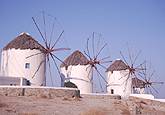
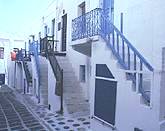
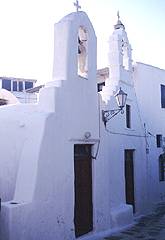
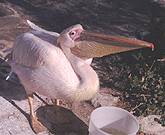
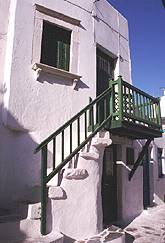
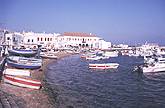
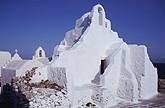
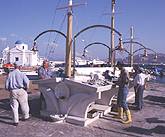
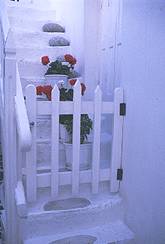
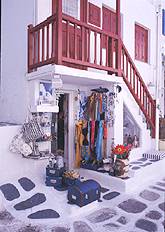
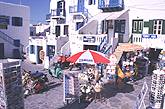
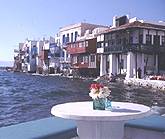
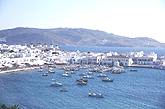

|













